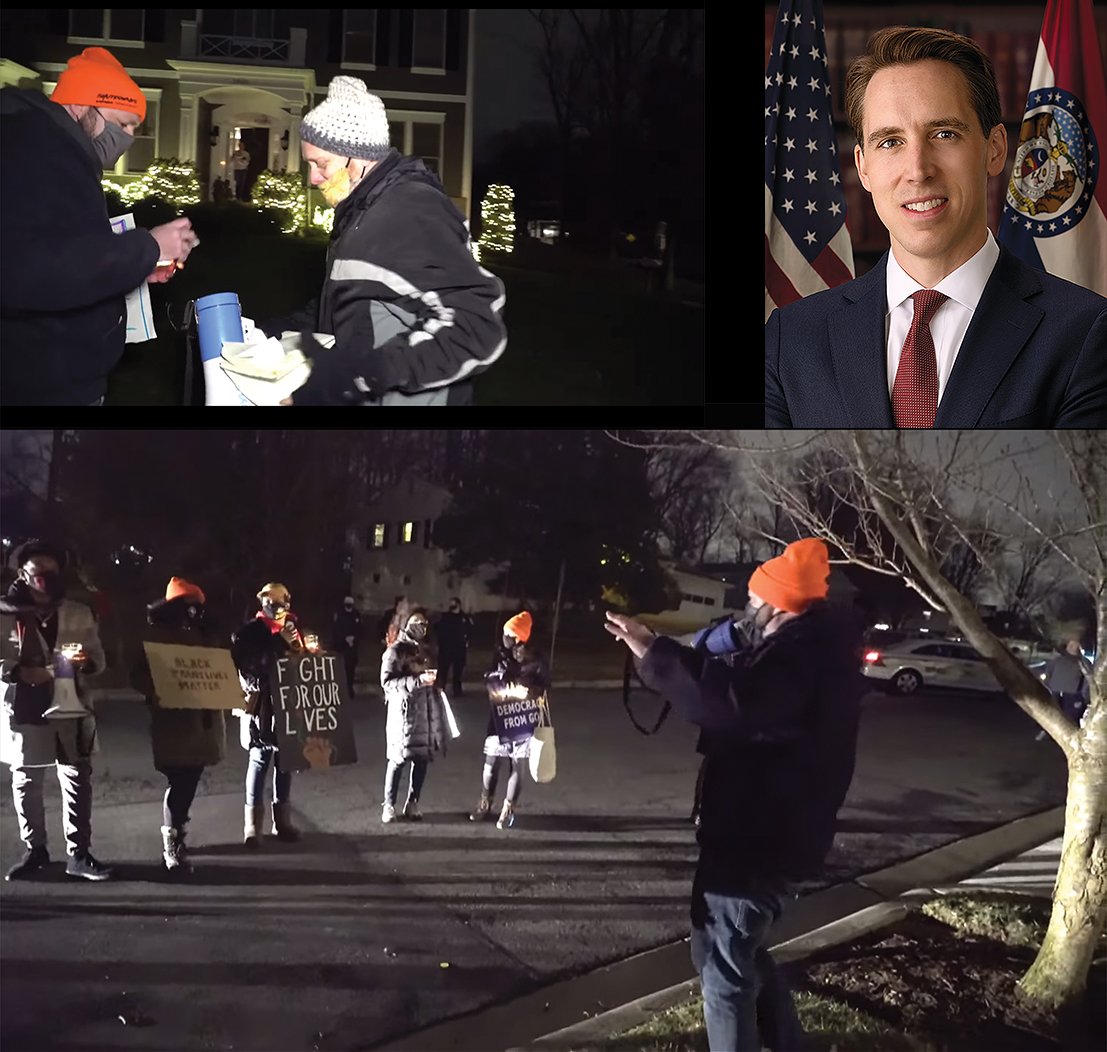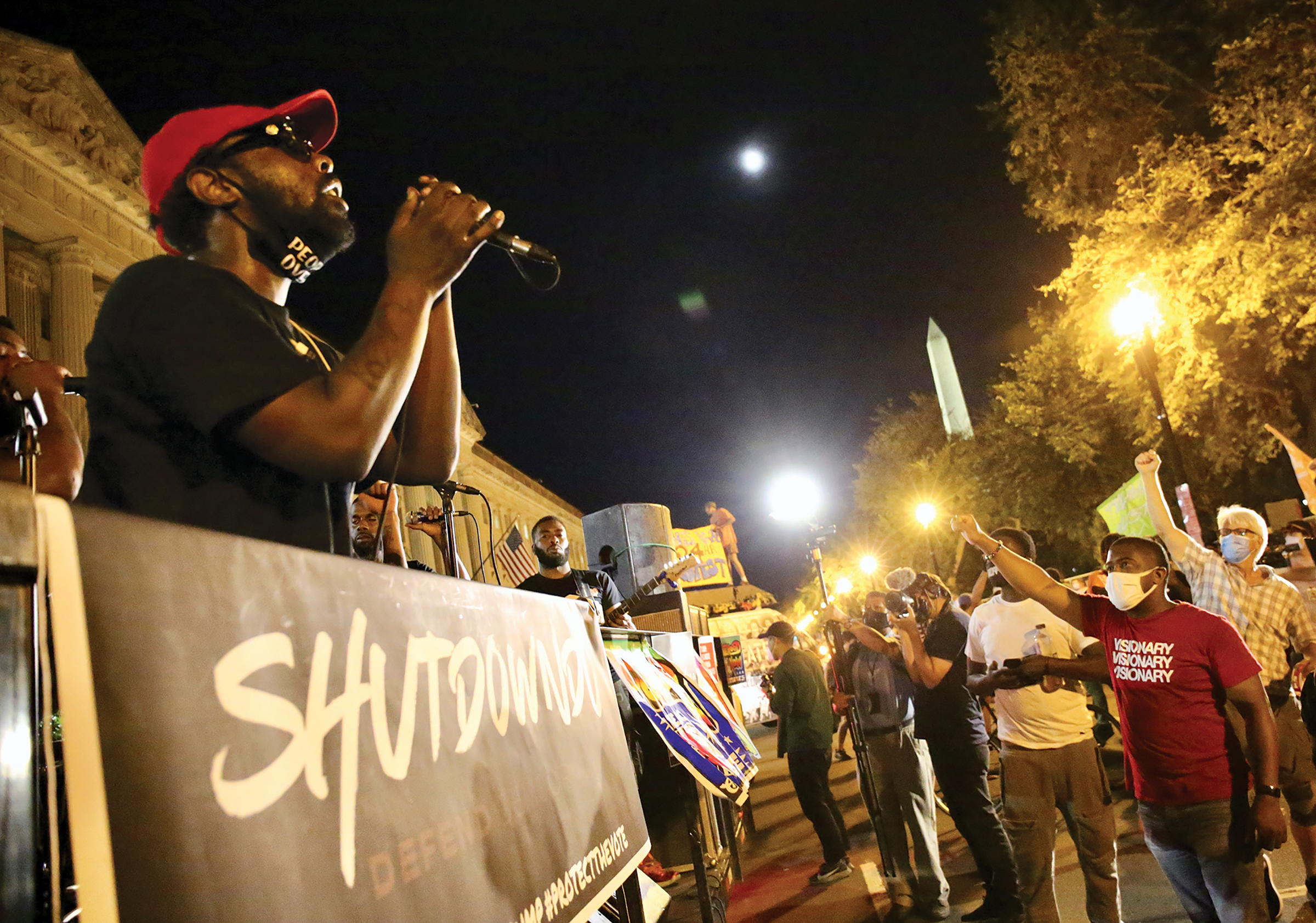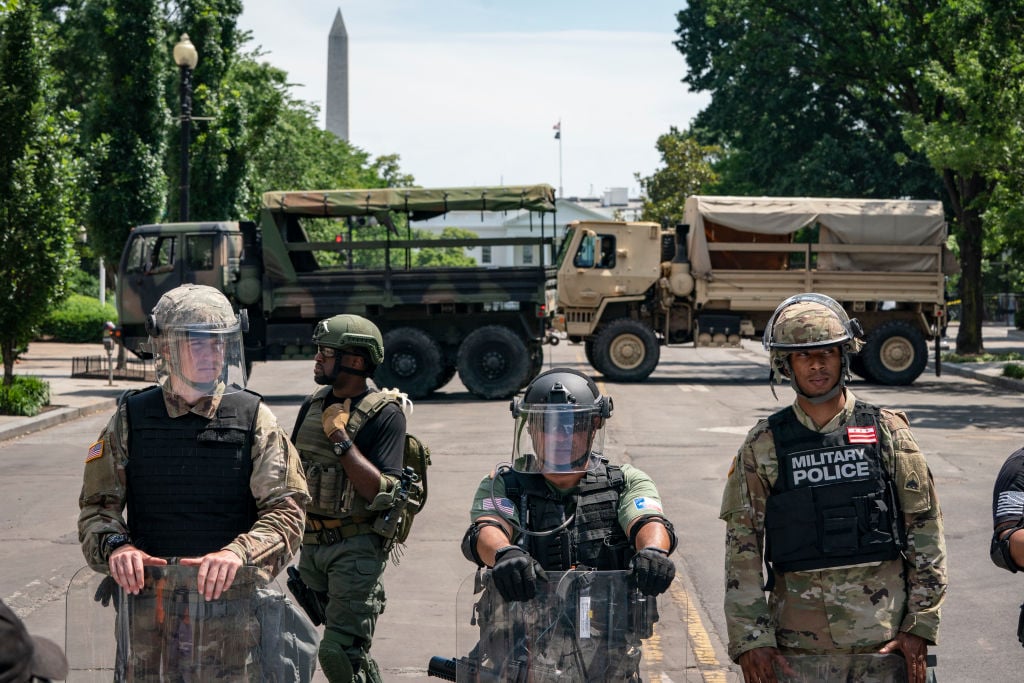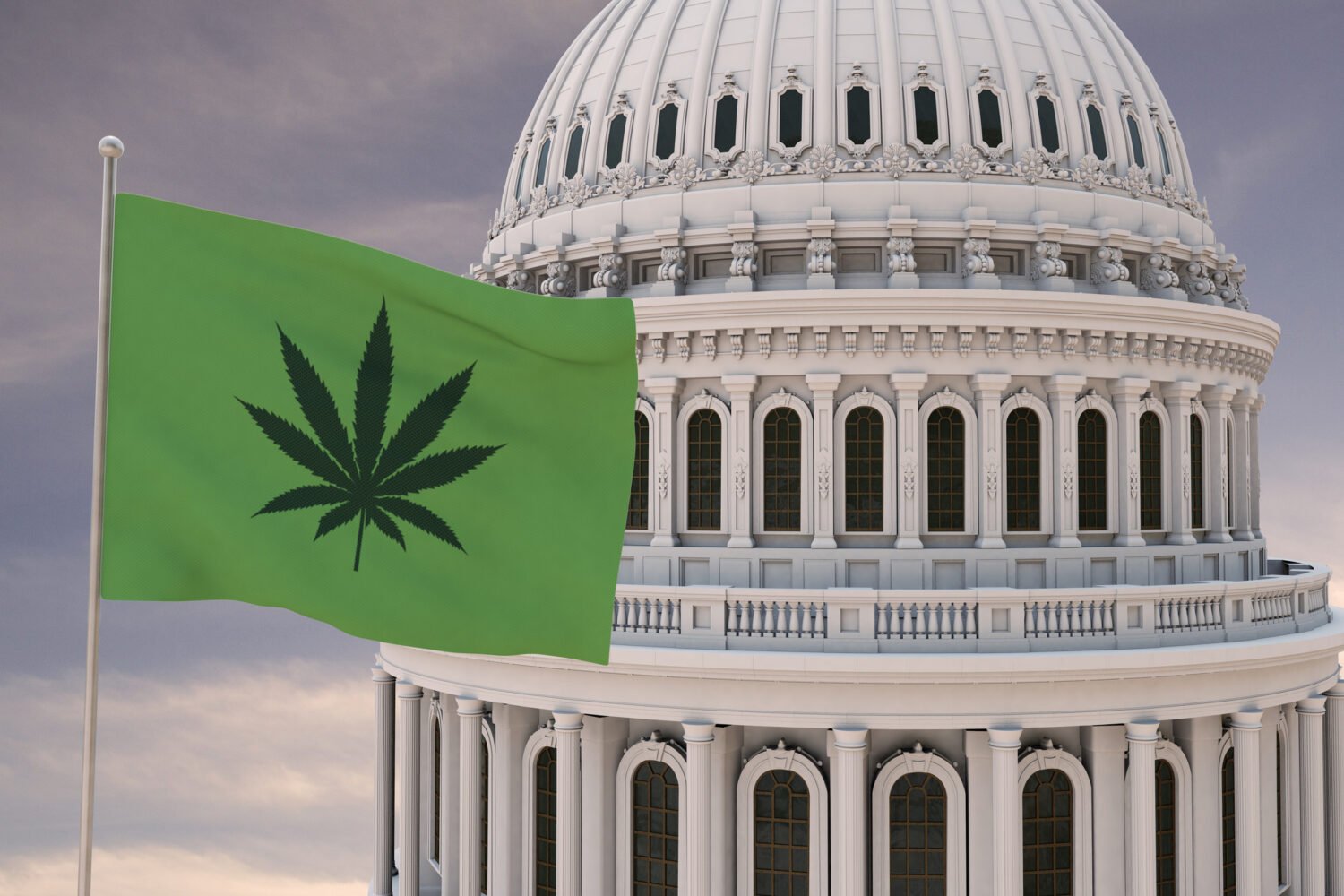US senator Josh Hawley’s home rises up on a corner lot, a French-gray, five-bedroom new-build that stands out among its tract-house neighbors in Vienna, white lights perfectly bedecking the shrubbery. “Ah, the fancy one,” someone commented. It was dark and cold the night the protesters showed up, around 7:30, and few lights were on inside. “It would be great,” one of the activists quipped, “if he opened the door in his pajamas.” Hawley, the Missouri Republican, had been dominating headlines after announcing he would object to Congress’s certification of the presidential election in favor of Joe Biden. ShutDownDC, the liberal activist group that itself had been making headlines for its efforts to stop Donald Trump from recapturing the White House, had decided to take its bullhorns directly to Hawley. And now, two days before the proceeding, here they were, marching down Patrick Street, toting YOU DON’T HAVE THE VOTES signs and Chinet cups filled with glowing tea candles.
On the sidewalk in front of the lawmaker’s house, someone pulled out a megaphone and kicked off the jeers.
“Hawley, Hawley, shame on you! Biden Harris won through and through!”
“Due diligence has been done! Biden Harris have won!”
The group, a little more than a dozen in all, struggled to chant in unison at times, until a shadowy figure appeared in the sidelight of the front entrance and the door opened. It was not the senator but his wife, Erin, holding the couple’s seven-week-old baby in her arms. “Could you cut it out, please?” she asked, according to video footage of the protest. “We’ve got neighbors and a baby. Thank you,” she said before retreating into the house.
They were not going to cut it out, not now. “We need a future for your baby!” one of the protesters shouted. Shortly afterward, three of them walked up to the door to deposit a copy of the Constitution. Article II, Section 1, the passage relevant to Hawley’s plan to contest Trump’s loss, was dog-eared.

Eventually, police arrived to explain that Virginia law prohibits protest in front of a residence. “Can we maybe quiet down until we have a supervisor out here?” one of the cops asked as the group yelled, “Shame! Shame!” Not long after, backup arrived—the demonstration was over.
That might have been the end of it. Except that later that night, Josh Hawley took to Twitter to rail against the incident. “Tonight while I was in Missouri, Antifa scumbags came to our place in DC and threatened my wife and newborn daughter . . .” he wrote. “They screamed threats, vandalized, and tried to pound open our door. Let me be clear: My family & I will not be intimidated by leftwing violence.”
The story was picked up by the Washington Post and other national media outlets, including the right-wing mediaverse—all of which reported that the event was peaceful. As a Vienna police spokesman put it at the time, “We didn’t think it was that big of a deal.” That, in turn, prompted a fresh rebuke from Hawley, and then a second life in the news cycle for the story. HAWLEY: WASHINGTON POST PRINTED ‘OUTRIGHT LIES’ TO DEFEND ‘ANTIFA SCUMBAGS’ WHO CONGREGATED AT HIS HOME, read a Fox News headline.
And it still wasn’t over. A whole month later, after the Capitol riot and the sudden stink surrounding her husband’s reputation, Erin Hawley pressed charges against Patrick Young, one of ShutDownDC’s founders, and a magistrate judge issued a summons finding probable cause that state law had been broken. “Had they been home, the night-time protest would have had more than a ‘minor’ effect on our two small boys, as it would have on anyone’s small children,” she wrote in a subsequent Fox op-ed. “And wasn’t that really the point? Why else would protestors come armed with bullhorns to a family home at dark? What other purpose to staging a night-time protest if not to terrorize the almost-certainly-to-be-home family?” (A hearing in the misdemeanor case was scheduled for April 19.)
Who came out on top in the debacle? An operative on the right might have thanked ShutDown for the optics: Alighting at Hawley’s doorstep, in front of his wife and baby, handed the 2024 presidential hopeful a set of talking points tailor-made for the MAGA faithful. Seen from the other side, the Republican was a combatant in a war against democracy—and then, hypocritically, was asking opponents to hew to standards from a gentler era. Bringing protests to his door, the logic went, would galvanize the anti-MAGA faithful.
That split-screen is part of what has made ShutDown so fascinating to watch over the past year. Between its massive street blockage in 2019 and its pot-banging “wake-up” calls outside lawmakers’ homes in 2020, the group has made it clear it has no use for the time-honored tactics of federal-city protest, such as marches on the Mall or rallies on the plazas around Capitol Hill. Nor does it harbor much respect for the boundaries that have traditionally insulated public officials from outcry while going about their lives as private citizens within our city—a fact that has all kinds of implications for officials themselves and for those of us who happen to live on their street.
ShutDownDC was supposed to be a one-and-done demonstration, the product of a moment before Covid, before the Capitol insurrection, and—more crucially—before the city had abandoned its daily commute. In that distant-seeming summer of 2019, Greta Thunberg, the Gen-Z celeb of climate-change activism, was calling for adults around the world to support the younger generation with a global climate strike. And a recently arrived Washingtonian named Patrick Young was puzzling over what DC could do.
Young had just wrapped up a master’s in industrial and labor relations at Cornell and moved to Washington to work for the Teamsters. Thirty-seven, the son of an education lawyer and guidance counselor from central New York (Elmira, to be exact), Young is a camp-and-kayak-on-the-weekends kind of guy who might struggle to clock a workweek in a city if it didn’t have a height limit and a skyline. Though he was still figuring out the vibe of the capital’s different neighborhoods—he and his fiancée live in a rowhouse in Petworth, where their three cats like to roam the neighbors’ roofs—his near-decade of organizing with a climate-justice group had turned him into an über-connected organizer. And he had a novel idea to supplement the global strike: Instead of parading at some classic Washington spot, thousands of activists from different groups would join forces for a large-scale event and usurp the flow of some daily norm.

Fellow lefties and organizers loved the grandness of the pitch—and the transgressive spirit. They workshopped it, and soon the plan was devised to block major intersections, wreak havoc on rush hour, and, as it were, shut down DC. By late summer, a cohort of founding ShutDown members had formed, some fellow newcomers, others veterans of DC’s lefty scene. They’re still together: Kathleen Brophy, 31, who helps with logistics, runs a coalition that keeps tabs on the oil, gas, and mining industries during the week. Kaela Bamberger, 29, is a Fulbright scholar turned journalist turned advocate who handles the group’s press. Daniel Dixon, 29, who was raised by evangelical missionaries bouncing between Kenya and Oregon, coordinates ShutDown’s outreach while studying remotely for a graduate degree in community development from a Canadian school called the North American Institute for Indigenous Theological Studies.
A lifer of lefty activism, Bill Ragen, who’s 63 and one of ShutDown’s strategists, spent more than a quarter century at SEIU—where he was national director of the enormously successful Justice for Janitors movement in the 1990s—before retiring early and kicking off a second act as a climate activist. Nadine Bloch, 59, one of the group’s creative leads, worked the Greenpeace boats in the ’90s, built giant puppets for the 1999 World Trade Organization demonstrations in Seattle, and got cuffed with her daughter after protesting Justice Brett Kavanaugh’s confirmation hearings in 2018 while dressed in Handmaid’s Tale cloaks. DC native Nee Nee Taylor, whose activist mother used to take her out to campaign for city-council candidates in the ’70s, has been in a leader in the District’s Black Lives Matter movement and helps ShutDown figure out how to best support the causes of BIPOC individuals.
Planning a large-scale action like the one Young imagined typically takes months—you need to line up manpower and train everyone, tasks that can take hundreds of hours. ShutDown had little more than six weeks, a fact that made veteran activists like Ragen distinctly nervous.
It didn’t help that a practice run was marred by mishaps. As members of the group blocked Florida Avenue one night a week and a half before the big strike, a man was blocked from visiting his hospitalized wife. Complaints arose that the majority-white group wasn’t addressing the needs of people of color. One participant commented, “It doesn’t seem like we’re really going against the people in power by doing this.”

Yet on the morning of September 23, the group pulled it off, sending some 2,000 activists onto DC thoroughfares at 7 am, right on schedule.
At some intersections, the call for climate action was clear—dozens of students choked off New York Avenue and I-395 with signs reading HONK 4 CLIMATE ACTION, and at Massachusetts Avenue near Dupont Circle, activists who were perched atop ladders decorated with wooden flames chanted, “The earth is on fire!” Elsewhere, cascades of confetti fluttered over the Daisy Dukes of protesters twerking in defiance of Big Oil near Union Station. As one bystander watched activists chained to a Pepto Bismol–pink sloop blocking 16th and K streets get covered in flame-retardant cloth so police could safely buzz-saw their shackles and clear the street, he told the Post, “I don’t even know what the message is, they need to get some signs up.”
The whole ordeal lasted into the early afternoon. When police removed demonstrators from one intersection, they simply marched to another, bringing traffic to a crawl. Officials reported 15 major intersections blocked in all, with traffic gummed up on K Street at one point and cars on 395 diverted at another. The situation was so dire that some transportation officials suggested that commuters consider teleworking.
ShutDownDC had indeed shut down DC. And it had also ruined the days of a lot of people who might otherwise be sympathetic to the cause. A mixed result? Nope. By the end of it, instead of quitting, ShutDown was on the verge of becoming a thing.
Then the pandemic hit. ShutDown’s plans for a next act—a monster shutdown to mark the 50th anniversary of Earth Day—were canceled. So was nearly everything else.

But 2020, in all its disastrous tumult, was not a year when it was easy for activists to stay home—or for environmentalists to stick to their particular cause. ShutDown demonstrators went to the Capitol to wave a banner in support of Covid relief. They held a bike ride to rally for workers’ rights. And after George Floyd was killed by police in Minneapolis, they showed up to BIPOC-group-led protests all summer, pitching in with PA systems and making fundraising appeals, too. Now an election was looming.
In August, Postmaster General Louis DeJoy came under fire for proposing significant cost-cutting measures just months before a heavily mail-in election—something that prompted nationwide worry about election fairness. At ShutDown, it prompted another question: How to amp up the pressure on an official who appeared to wield such outsize influence yet whom people barely knew?
Maybe . . . make a house call?
Protesting in front of Lindsey Graham’s house gives him something to campaign on. He can write, ‘They’re terrorists, they’re assaulting us,’ and use it to deflect anything that is done by groups like the Proud Boys.
ShutDown had previously staged a couple of small demonstrations at the homes of Amazon chief Jeff Bezos and DHS Secretary Chad Wolf and had gotten a little pop in the press. This time, they scheduled the protest for 8 am on a Saturday morning, gathered a bunch of noisemakers, and printed mock ballots to slip through DeJoy’s front door. The next day, a group in North Carolina led their own protest outside his Greensboro mansion.
DeJoy was ordered to the Hill to testify the following week. To keep up the pressure, ShutDown scheduled a new event at the postmaster general’s home on the eve of the House hearing: a Sunday-night street party. Outside his apartment building in stately Kalorama, some 200 revelers bumped to the beats of Long Live GoGo, a musical activist group, and grooved to riffs of “Please Mr. Postman” as if they were at a late-summer music festival, a couple of potent spliffs coating the muggy air.
So it was that ShutDown stumbled into a new MO: the festive house-call protest. They hit GOP senator Lindsey Graham, then Mitch McConnell, then they dropped body bags in front of the homes of fellow lawmakers Susan Collins and Jim Inhofe (plus Graham and McConnell again), lapping up love from lefty Twitter and inspiring other DC groups to stage their own demonstrations.

Protests at political figures’ homes were not entirely new to Washington—activists once showed up outside the residence of Fox host Tucker Carlson and staged a Pride-themed dance party outside the rental that Mike Pence used during his vice-presidential transition. The boundaries between on-duty and off-duty had been breaking down for some time: The string of incidents in which Trump-administration officials were heckled in restaurants was seen as a significant departure from capital norms, which had theretofore dictated that even the most disreputable pols could enjoy a pizza outing in peace.
ShutDown, though, escalated the tactic—even, perhaps, normalized it, with the frequency of the actions, their ability to draw crowds, and a captive audience doomscrolling 24-7 from home quarantine. It was not entirely a product of grand strategy: With the pandemic having closed the Capitol and kept powerful people away from their offices, homes became a destination of necessity. For a moment, it felt as though each new week of company-town, federal chaos brought a new wake-up call on a street you’d been down a million times but you’d never known who lived there (and on the flip side, a street whose occupants might not have wanted a fresh reminder of who lived down the block). Was this acceptable for Washington now?
And because this is Washington, the debate quickly moved from cultural norms to more familiar terrain: Who’s winning in this new normal?

It comes down to what activists might call a theory of change: How does your particular protest lead to the outcome you want? Martin Luther King Jr. could have done all kinds of things to demand racial justice, but he embraced nonviolent confrontation on the logic that scenes of law enforcement assaulting peaceful crowds would foment public opinion and garner support in Washington. By that calculus, it was worth the significant cost in protesters’ bloodied heads.
For ShutDownDC, the theory of change is that taking the pots and pans to pols’ houses, breaking from the scripted norms of official protests, is a way of making waves in the long stream of social media, driving headlines, putting the uncomfortable lens on hostile officials, and winning new recruits to the cause. It would be hard to do that via the standard tactics of blast emails and Capitol pickets.
But the costs are quite clear, too—the risk of political blowback for looking like jerks. Or, in the longer sweep of history, the possibility that chucking the former rules is actually damaging in a broader way.
“Protesting in front of Lindsey Graham’s house . . . [gives] him something to campaign on,” says Cathy Lisa Schneider, a professor in the School of International Service at American University who studies social movements and urban politics. “He can write, ‘They’re terrorists, they’re assaulting us,’ and use it to deflect anything that is done by groups like the Proud Boys by saying, ‘Well, look at what the left does.’ ” Indeed, after his home was visited for the first time, Graham saw an opportunity to buckrake. “So how did your Monday start? Stand with me against the mob,” he tweeted, linking to his campaign donation page.
That kind of optic can impose an even more serious secondary cost, Schneider says. Instead of bringing attention to the issues you’re protesting, you’re “inciting an ethical debate about whether it’s helpful or not to harass somebody.” For example: In the age of doxxing and conspiracy theorists primed to show up at a pizzeria armed with delusions about child sex traffickers as well as actual weapons, is it fair to wonder if the left shouldn’t eschew methods that veer anywhere near the invasions of privacy that the right has used to wreak terror? Just because rightists have breached boundaries around individuals’ private lives, are progressives wise to do the same?
Mark Lance, cofounder of Georgetown University’s Program on Justice and Peace, which teaches students how to combat systemic injustices with nonviolent tactics, says the ethics of ShutDown-style house calls would be more black-and-white in a dictatorship like Argentina in the early ’80s, where the military tortured and murdered thousands. “I’m not going to be too concerned about the risks of disrupting the [general’s] personal life,” Lance says. Still, in his view, you could make a case in Trump’s America that the line was worth crossing because of how brutalized our expectations of normalcy and civic process became. “What we were seeing from our government was an attack on fundamental institutions of power and representative democracy,” says Lance.
Young, of course, doesn’t buy the Foxified interpretation of ShutDownDC’s methods. He says he has thought about the dangers of invading private space, both from a messaging standpoint and an ethical one. It’s why he says ShutDown organizes party-style protests at its house calls. “Hearing loud music first thing in the morning isn’t what you want to hear . . . but there’s been no demonstration that I’ve been a part of where any reasonable person could have interpreted that there was a threat,” he says. If policymakers see it all as pot-banging that doesn’t merit a substantive response, or falsely portray it as mob action, too bad for them. Reacting to Twitter footage of McConnell’s wakeup call, GOP senator Tom Cotton tweeted, “I hate to break it to the liberal mob, but for grown-ups, 7:30 is a little late for a ‘wake-up.’ ”
But do it again and again and again and soon not only do you have a steady stream of new followers and allies, you have imitators—and in the case of the Hawley protest, for one, bragging rights. Washington politicos and the tech crowd previously knew him well, but the senator from Missouri wasn’t exactly top of mind in the national political consciousness before January 6. And ShutDown got to him first.
There was, you may remember, one ShutDown event of the past year where the cause-and-effect was starkly clear. After the Capitol riot on January 6, as the shaken city began worrying about Inauguration Day, the group got together to talk about what to do. The Proud Boys and other extremist groups were pledging another bout of terror, and Young didn’t want to sit it out.

“There’s a place for the type of action where people are going and directly confronting these violent right-wing extremists, and that’s something that we’re broadly supportive of, but a lot of us are just not good in a street fight,” he says. “So we’re like, ‘What can we do?’ Maybe the thing we can concentrate on is making sure there are fewer of them and make it harder for them to come into town.”
During previous “Stop the Steal” gatherings, MAGA demonstrators had rented Airbnbs all over town. That was their target, one they could hit without leaving home. ShutDown launched a pressure campaign against the Silicon Valley company and locals who rent their properties on the platform, and according to Bamberger, some 500 people signed up to send messages to more than 3,400 Airbnb listings in the area. Within a few days, they got a result: Airbnb announced it would be canceling all Washington reservations for the week of inauguration and would compensate hosts for their losses.
“I’m not surprised so many people participated in that,” Young says. “People were appalled about the way the Proud Boys behaved themselves in November and December, and they wanted to do something.” But, he adds, “I was frankly surprised to see Airbnb take the stance that they did.”
For ShutDown, there was a ripple effect: its highest visibility since the 2019 gridlock and a jump in its numbers. “Suddenly, people in my circle who I don’t know through ShutDownDC were saying, ‘Oh, there’s something we can do about this insurrection and the safety of our city,’ ” says Bamberger. “It felt like it swept my networks in a really effective way.”
ShutDown now touts a protest corps of 500 and has an email list in the tens of thousands. The group seems to have improved diversity in its leadership, too. Its Election Week party-protest at McPherson Square and Black Lives Matter Plaza last November—a sprawling event with live music, a jumbotron, and hundreds of attendees—was organized by Beth Yirga and LaDon Love, two Black women who also run a pair of groups advocating for racial justice on the local level.

But with last year (mostly) in the rearview mirror, does ShutDown have staying power? Twenty-twenty was the year of protests, a time when long-festering inequalities were laid bare, political temperatures spiked, and people readily flowed into the streets partly by virtue of the fact that they were either working from home, unemployed, or home from school. Plus, it’s hard to overstate the rallying power of the former President. “There are people who were activated because Trump was sort of such a great villain and such a grievous violation of liberal sensibilities,” Bamberger says. “But those aren’t necessarily people who gravitated toward ShutDownDC in the first place.”
Young wants to make sure the group keeps the pressure on President Biden and his party, especially regarding environmental issues. And certainly, the new rough-and-tumble of modern Democratic politics has laid out a road map for the far-left flank. There’s a debate within ShutDown, though, about whether their energy is better spent targeting the corporations that fund the people in power. Then there’s the toll from years of constant motion. “That issue of fatigue,” says Young, “is real.”
A winter protest in front of the EPA bore out the sentiment. Only a dozen or so ShutDowners showed up to march from the agency to Black Lives Matter Plaza to represent the demands of Indigenous peoples and “directly reach the Biden administration” via a banner and a video truck that clearly weren’t going to be visible from the West Wing.
In recent weeks, the group has been Zooming and messaging on the regular, trying to plot out plans for the future. For as much change as it has brought to DC protest tactics, it seems to know it might do better—and plans to keep experimenting. “Civil resistance . . . is an art, not a science,” says Bloch, who, 20-plus years ago, protested US sanctions on Iraq by going to Madeleine Albright’s Georgetown home with blood-splattered baby dolls. “Otherwise we would have won a lot more.”
This article appears in the May 2021 issue.








